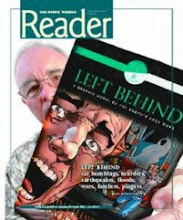 Wednesday, Mar 30, 2011
Wednesday, Mar 30, 2011New religion
El Cajon homeless-services program cuts ties with its problematic past
(619) 442-0457 ext. 1114 Office or
The “saved” men are graduates of a one-year program that includes 90 days at a Dulzura ranch and nine months of sober living at a converted El Cajon motel operated by the East County Transitional Living Center (ECTLC). Brown’s the group’s CEO.
On March 19, ECTLC had a grand opening at the motel, a decades-old set of buildings under a rusted, kitschy sign that says “Fab 7,” the motel’s original name. ECTLC’s former incarnation, Set Free Ministries, had occupied the building since 2004, though, making this less a grand opening and more a re-branding.
“New services, new name, new management, new outlook on approaching the community,” says Sean Oliver, ECTLC’s director of development. “Set Free was very closed to working with others, whereas we’re the exact opposite.”
El Cajon’s Set Free had ties to the larger Set Free Ministries, an Orange County faith-based organization that started off as an evangelical biker gang before founder Phil Aguilar grew it into a mega-church with rehab ranches throughout the U.S.
Set Free was always controversial, with Aguilar being compared in news reports to cult leaders like David Koresh and Jim Jones. In 2008, Aguilar was arrested after several of his “Set Free Soldiers” got into a brawl with Hell’s Angels bikers at a Newport Beach bar (Aguilar, video footage showed, sat out the fight). Initially charged with attempted murder, Aguilar and three of his Soldiers ultimately pleaded to lesser weapons charges.
Though Brown says his organization’s affiliation with Set Free was a loose one, he realized it was time to make a split—not only because of what happened in Newport Beach, but also because Set Free’s religion-focused model narrowed the organization’s reach.
“We got help from [Set Free], and it was good for us, but that’s not who we are,” Brown says. “I don’t want any of that to hamper the ability to be able to take people off the street and give them hope, whether or not that’s here or whether that’s by us finding them another program that’s more suitable for them somewhere else.”
Though folks who take advantage of ECTLC’s transitional housing and emergency shelter services aren’t expected to participate in religious activities, the organization’s spiritual leanings are evident throughout the property, from crosses on some motel-room doors to a Bible verse painted in the kids’ play area. Brown’s also the pastor of the adjacent church. But, he says, “we also understand that not everybody’s going to receive the gospel. Not everybody comes here looking for salvation through Christ.”
East County contains less than one-tenth of the region’s homeless population (802 people out of 9,020 countywide, according to a recent count by the Regional Task Force on the Homeless), but it has a high poverty rate and lots of people teetering on the edge of homelessness. In El Cajon, 21 percent of residents live below the poverty line (a $21,834 annual income for a family of four), according to U.S. Census Data, compared with the county average of 12.6 percent.
For now, ECTLC employs only one social worker, Denise Schoolcraft, who estimates her caseload is upwards of 100 people at any given time. The organization’s annual operating budget is $1.1 million, and it provides housing for 300 people, Oliver says. Those limited means manifest themselves in things like white-painted Xs in the parking spaces in front of the women’s transitional-housing portion of the motel.
“No man’s land,” Oliver explains. “Men are not allowed to step inside that box.”
Though Oliver was never homeless, he did go through ECTLC’s rehab program. He wasn’t a religious person before that, he says.
“I had been through other programs, I had been through secular things, I had been through court-mandated things, and none of it stuck until I came here,” he explains. Before, he says, “there was nothing to fill the emptiness that was left.”
Though research has shown that spirituality can help a person kick an addiction and stay sober, there’s a counter argument that religious-based recovery programs simply replace one addiction with another.
“That’s a great addiction to have, then,” Oliver says. “If I’m going to be addicted to something, I’d rather it be my spirituality and my closeness with God.”
Amid ECTLC’s overhaul, the rehab program has stayed grounded in the philosophy that addiction and homelessness are the products of a person’s bad choices. Brown, who was once a homeless alcoholic, explains the approach matter-of-factly.
“Each one of those people that are sitting there, laying on the street… it’s their fault,” he says. “It’s not society’s fault, it’s not the government’s fault and the government doesn’t have a responsibility to fix it…. You choose; it’s as simple as that.
“It’s always the individual’s choice,” he says. “I know—I was on the street; I chose to be there. After awhile, it gets kind of easy.”
Jarring, maybe, but there’s a reason that kind of treatment approach works, says Patricia Leslie, director of Point Loma Nazarene University’s social-work program.
“If you say to the person, ‘Oh, you’re a victim of the system,’ that means that unless you can impact the system, you have no hope. But if the person has choices and options, and their choices and options contribute to them being there or not, it puts some of the power back into the individual’s hands.”
It also jibes with the reigning American ethos of personal responsibility, she says.
“Unfortunately, what it doesn’t take into account is what we learned during the Great Depression, which is that there are also some systemic and structural issues here, like, if you can’t find housing because there is no housing available, or you can’t find affordable housing because all of the affordable housing is [priced] at 80 percent of area-median income and you’ve got 20 percent of area-median income.”
One-fifth of ECTLC’s budget comes from its work program. Program participants staff concessions at 81 Padres games per season, which brings up another piece of his organization’s past that Brown would like to forget. In July 2007, when a Padres hat giveaway marketed to kids coincided with the lesbian-and-gay “Out at the Park” event, Brown decided his crew wouldn’t work concessions that day. But the Gay & Lesbian Times accused the organization of coordinating a game-day protest. Brown says that wasn’t the case.
“We weren’t there protesting,” he says. “We didn’t go to work that day.”
He says he regrets that decision.
“If... on Tuesday, April 5, they declared that to be a floppy-hat giveaway with the gay-and-lesbian choir singing the National Anthem, we’ll be there. That’s just not a fight that I should be involved with. In retrospect, I regret that, and you can print that.”
As for the success rate of his program, Brown says that of the people who enter the first phase—90 days at the ranch—probably half leave. “And of those, about half of them come back.”
Though the rehab program’s faith-based approach prevents ECTLC from tapping into certain sources of funding (its secular programs don’t have similar limitations), being affiliated with a church has given Brown a way to track the long-term success of graduates. “Success is all the way to the end,” he says. He makes sure that people return to their family, or he keeps an eye out for them at church services.
Point Loma’s Leslie says that, in her experience, relationships are what keep people from slipping back into addictions.
“Whether it’s a relationship with the maker, relationship with community, relationship with the case manager. The bottom line is some sort of viable, caring relationship,” she says.
Write to kellyd@sdcitybeat.com and editor@sdcitybeat.com
























No comments:
Post a Comment